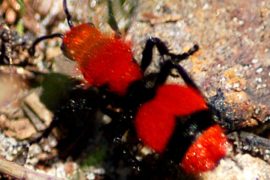Everyone who owns an aquarium knows them: sooner or later algae can be found in every tank. While some species of algae, such as green algae, are tolerated or even welcome guests, others drive aquarists to despair – especially if they persist, overgrow panes and decorative objects, or even affect plant growth. With a little background knowledge, however, it is not that difficult to identify and eliminate the causes of increased algae growth. In this article, we would like to give you some important tips on combating and preventing algae.
Table of Contents
The following types of algae can occur in the aquarium:
- Green algae (thread algae, spot algae, floating algae, hair algae, …)
- Red algae (brush algae, beard algae)
- Brown algae (diatoms)
- blue-green algae
What are algae and how are they formed?
Most algae, as we know them from our aquariums, belong to the aquatic plants, but not to the higher ones, but to the so-called lower ones. (An exception is the slime algae, which are cyanobacteria.) Algae have a lot in common with aquarium plants: they share a habitat and carry out photosynthesis, i.e. converting nutrients into plant matter with the help of sunlight. In order to grow, they need exactly the same things as aquatic plants, namely nutrients and light.
However, algae are less demanding and much more adaptable than higher plants. Therefore, they still feel comfortable there, where aquarium plants already have difficulties, reduce their growth or even die. And this is exactly the reason why algae can spread rapidly when an imbalance has set in the aquarium and make it difficult for the aquarium plants to keep the upper hand or regain it. If you create the conditions for good plant growth in your aquarium, algae hardly stand a chance in the long run.
In short: you will never have a completely algae-free aquarium. The good news is that this is not necessary or desirable. It is not possible to protect an aquarium from algae being “introduced”. Algae spores can always be found somewhere – in the transport of water from purchased fish, on plants or decorative material, and even in the air.
This is perfectly normal and usually doesn’t have much of an impact. Because algae only gain a foothold where plant growth is disturbed. And some types of algae, such as the popular moss balls, are even cultivated and lovingly cared for by some aquarium owners. Just like aquatic plants, algae produce oxygen, have a positive influence on the water chemistry, and offer the aquarium inhabitants a natural habitat.
Avoid algae, improve plant growth: a checklist
Would you like a visually appealing aquarium without disturbing algae growth? Or have you discovered algae that are starting to multiply in your tank? Then you should use our checklist to check the following points.
- planting of the aquarium
- lighting conditions and lighting
- water quality and nutrient supply
- stocking and feeding
Increased formation of algae is always a sign that there is an imbalance in the aquarium or that certain conditions are not ideal. The above points are the main ones to pay attention to. We will explain this to you in more detail below.
Planting and health of aquarium plants
Basically, lush, healthy plant growth is the best weapon against unwanted algae. Aquatic plants absorb nitrate and phosphate from the water and are essential for healthy water chemistry. At the same time, they compete with algae for food, so that they do not multiply uncontrollably in a tank with good water quality, appropriate lighting, and nutrient supply for the plants.
Therefore, when purchasing aquarium plants, you should always make sure that you choose varieties that can grow optimally under the given circumstances. If you occasionally have to deal with some unwanted algae in your aquarium, one of the simplest solutions is to use fast-growing aquarium plants. Bunch plants or stem plants, in particular, have proven themselves here, since these are mostly species that adapt easily, grow quickly and represent strong competition for the algae.
Lighting conditions and lighting
Lighting also plays an important role in the development of algae. Basically, the aquarium should be set up in such a way that no daylight falls on it. The light that shines on the aquarium from the window is sufficient to stimulate algae growth, but cannot be used by the plants. Therefore, always make sure to place the aquarium in a place where it does not receive direct natural light. You should select the lighting for your aquarium in such a way that the light intensity is sufficient to provide light-hungry plants in all areas of the tank with sufficient water.
It is also important to replace fluorescent tubes regularly, as the luminosity decreases over time and the light spectrum changes. A rule of thumb is that aquatic plants thrive in long-wave red light, while algae prefer blue and UV light. Most aquarium owners adjust the lighting time of their tanks to roughly the length of a tropical day since this corresponds to the natural habitat of most plants and animals that are kept in aquariums. In connection with the topic of algae, it is important not to illuminate the pool for too long; a time of ten hours is the upper limit. With some types of algae, it can also help to reduce the lighting duration for a certain time or even to start a so-called “dark cure”.
Water quality and nutrient supply
The water quality, especially the nutrient content, is of great importance when it comes to the growth of algae as well as aquarium plants. If algae suddenly multiply rapidly, this is usually a sign of an imbalance in the aquarium. You should look for possible causes. Relevant water values can be easily determined with the help of water tests, which you can purchase in specialist shops, mostly as droplet tests. However, many aquarium dealers also offer a determination of the most important water values, often free of charge, sometimes for a small fee.
While very undemanding plants can already feed themselves well on the substances that fish or bacteria produce in the tank, many aquarium plants need fertilizer, which they absorb from the substrate via the roots or from the water via the leaves. In addition to CO2, the most important nutrients for plants include nitrogen (N), phosphorus, iron (Fe), and manganese (Mn). However, demanding aquatic plants also need micronutrients such as copper, zinc, molybdenum, and borate, which are contained in special fertilizers, for healthy growth.
Stocking and feeding
If your aquarium is overloaded with fish, this not only has a negative effect on their well-being but also on that of the plants. The accumulation of substances that cannot be completely broken down by aquatic plants and bacteria creates a rich supply of nutrients for the algae and creates a difficult environment for healthy plant growth.
ATTENTION: Feed the animals that you keep in your aquarium only enough so that no residues remain in the water. The food should be completely eaten up within a minute and not spread unnecessarily in the water and pollute it.
A very efficient method of keeping algae in the tank to a minimum is to include a few algae eaters in the aquarium when stocking it. Many species of fish, shrimp, or snail-like eat algae and can help keep it at bay. Since these animals only consume the algae and not the aquatic plants, this is an excellent method when it comes to giving the aquatic plants a decisive advantage over their food competitors, algae.
What are your experiences with algae? We look forward to your tips and comments!





